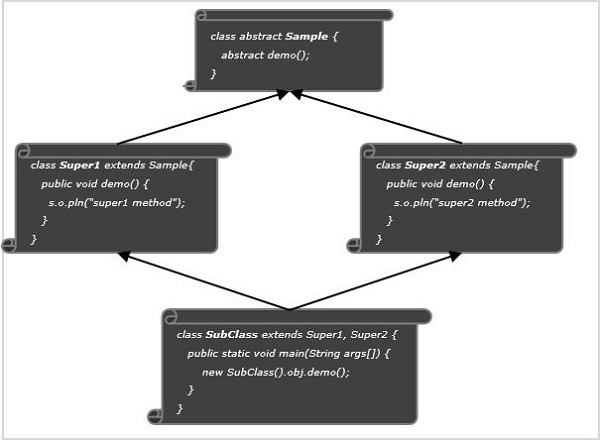
 Data Structure
Data Structure Networking
Networking RDBMS
RDBMS Operating System
Operating System Java
Java MS Excel
MS Excel iOS
iOS HTML
HTML CSS
CSS Android
Android Python
Python C Programming
C Programming C++
C++ C#
C# MongoDB
MongoDB MySQL
MySQL Javascript
Javascript PHP
PHP
- Selected Reading
- UPSC IAS Exams Notes
- Developer's Best Practices
- Questions and Answers
- Effective Resume Writing
- HR Interview Questions
- Computer Glossary
- Who is Who
What is diamond problem in case of multiple inheritance in java?
Inheritance is a relation between two classes where one class inherits the properties of the other class. This relation can be defined using the extends keyword as −
public class A extends B{
}
The class which inherits the properties is known as sub class or, child class and the class whose properties are inherited is super class or, parent class.
In inheritance a copy of super class members is created in the sub class object. Therefore, using the sub class object you can access the members of the both classes.
Multiple inheritance
There are various types of inheritance available namely single, multilevel, hierarchical, multiple and, hybrid.
In multiple inheritance one class inherits the properties of multiple classes. In other words, in multiple inheritance we can have one child class and n number of parent classes. Java does not support multiple inheritance (with classes).
The diamond problem
For instance, let us assume that Java does support multiple inheritance. With that assumption consider the following example.
Example
Here, we have an abstract class named Sample with an abstract method as −
public class abstract Sample {
public abstract demo();
}
Then in the same package/folder, we have two classes extending this class and trying to implement its abstract method, demo().
public class Super1 extends Sample{
public void demo() {
System.out.println("demo method of super1");
}
}
public class Super2 extends Sample{
public void demo() {
System.out.println("demo method of super2");
}
}
According to our assumption, since Java supports multiple inheritance, we are trying to inherit both classes Super1 and Super2.
public class SubClass extends Super1, Super2 {
public static void main(String args[]) {
SubClass obj = new SubClass();
obj.demo();
}
}
Then, as per the basic rule of inheritance, a copy of both demo() methods should be created in the subclass object which leaves the subclass with two methods with same prototype (name and arguments). Then, if you call the demo() method using the object of the subclass compiler faces an ambiguous situation not knowing which method to call. This issue is known as diamond problem in Java.

Due to this Java does not support multiple inheritance i.e., you cannot extend more than one other class. Still, if you try to do so, a compile time error is generated.
Compile time error
On compiling, the above program generates the following error −
MultipleInheritanceExample.java:9: error: '{' expected
public class MultipleInheritanceExample extends MyInterface1, MyInterface2{
^
1 error
Solution
You can achieve multiple inheritance in Java, using the default methods (Java8) and interfaces.
From Java8 on wards default methods are introduced in an interface. Unlike other abstract methods these are the methods of an interface with a default implementation. If you have default method in an interface, it is not mandatory to override (provide body) it in the classes that are already implementing this interface.
You can have same default methods (same name and signature) in two different interfaces and, from a class you can implement these two interfaces.
If you do so, you must override the default method from the class explicitly specifying the default method along with its interface name.
Example
interface MyInterface1{
public static int num = 100;
public default void display() {
System.out.println("display method of MyInterface1");
}
}
interface MyInterface2{
public static int num = 1000;
public default void display() {
System.out.println("display method of MyInterface2");
}
}
public class InterfaceExample implements MyInterface1, MyInterface2{
public void display() {
MyInterface1.super.display();
//or,
MyInterface2.super.display();
}
public static void main(String args[]) {
InterfaceExample obj = new InterfaceExample();
obj.display();
}
}
Output
display method of MyInterface1 display method of MyInterface2

